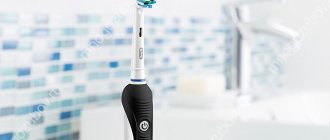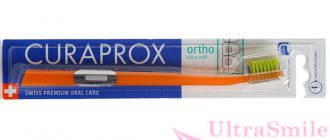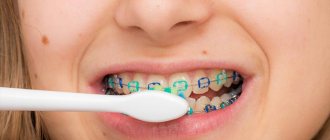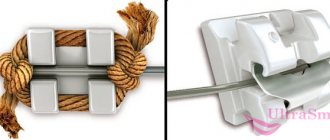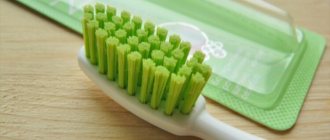People who respect themselves and others are raised from childhood to constantly monitor and care for their teeth and mouth. They know that beautiful white teeth and pleasant breath affect health, personal life, and help build a successful career.
And in order for everything to always be in order in your mouth, you need to brush your teeth regularly - this has been known since childhood. The most popular item for oral care is an ordinary toothbrush. Parents teach them to use it from a very early age. However, even they do not always know the criteria for choosing a much-needed tool. They often do not know how to care for it and how often to change it.
Those who do not know the answers to these simple and important questions are very likely to risk damaging both their tooth enamel and gums. There is a high risk of getting a bunch of incurable diseases, and not only the mouth, but also other organs will be affected. To prevent this from happening, you should pay attention to some nuances when buying a toothbrush.
Brush selection methods
Typically, toothbrushes are purchased in modern perfume stores or pharmacies. When choosing, many people look at price and appearance and focus only on them, but these are by no means the main indicators. What should you pay attention to, how to choose correctly?
The first factor that you should take a close look at is the material used to make the bristles. There is an opinion that natural bristles are the best option. But this is far from true. Bacteria accumulate on it, leading to oral diseases. The best one is artificial: it has harder fibers, and the tips do not scratch the enamel, destroying it.
Information about the stiffness of the bristles is written on the packaging or the brush itself. According to the degree of hardness, brushes can be
- Very soft. Recommended for little ones or those with extremely sensitive teeth.
- Soft. Designed for older children 6–13 years old, recommended for adults with oral health problems
- Average. Good for teenagers.
- Tough. These brushes are used by adults with absolutely healthy teeth. Before use, it is recommended to consult a dentist, otherwise there is a risk of damage to the gums and enamel.
Distinctive features of a soft toothbrush
Keep in mind! If you are an adult with dental problems: a soft toothbrush is what you need.
The plastic bristle gently cleanses the enamel without causing discomfort or provoking inflammatory complications.
However, such bristles cannot penetrate the narrow interdental spaces .
The product marked soft or medium has a stiffer bristle and is suitable for people with a healthy oral cavity.
In any case, you can use dental floss to clean hard-to-reach areas .
Using water
How to make a toothbrush soft? Often people purchase a brush with the required parameters, but after some time it becomes too hard, rubs the gums and causes discomfort. What can you do in this case, without running back to the store for a new copy? There are several tools that can make your toothbrush soft and brushing your teeth a pleasant and comfortable experience.
The easiest and most affordable way to soften a brush is with ordinary tap water. How to do it? Follow the instructions below:
- Under running hot water - there is absolutely no need for it to be boiling water. Otherwise, the plastic bristles will simply melt. You need to hold it with the bristles up for several (2-3) minutes.
- Then put hot water in a glass or jar and leave the brush there for 5–7 hours. The best thing is to do this in the evening after brushing your teeth before going to bed.
- In the morning, when you start brushing your teeth, you may find that the bristles have become soft.
Aloe Vera - with faith in the best
I was skeptical about this option. It’s one thing to add extract to women’s hand creams. It’s quite another to soften a stiff and dry toothbrush. Well, okay, let's try.
Aloe Vera Gel
Tips from the Internet say:
- pour some aloe gel into a glass;
- lower the brush there;
- leave for 5-10 minutes.
It took me about 10 minutes to make sure that the humidifier was working. After this, you need to rinse the bristles under water. I haven’t tried the options with soda and salt.
Common sense dictates that modern brushes can only deteriorate from such chemical experiments.
As for salt and soda, it is better not to use them
Comparing the “cheap and cheerful” options with water and “expert advice” about aloe, I will say that I did not find any huge difference. In both cases, the bristles have become softer and brushes teeth normally. If you have gum disease, don't even try using hard brushes. This is quite capable of causing exacerbations and even tooth loss.
Using hydrogen peroxide
Another way to soften your toothbrush is to use hydrogen peroxide. It is best to take a three percent solution. This is usually present in the first aid kit of anyone who takes care of their health.
Peroxide is poured into a glass or mug one third full, and a brush is placed in it for about 5–7 minutes. Then it is thoroughly washed. That's it, now you can use it.
We strive for natural: bamboo and bristles with silver ions
The modern market is rich in various modifications of hygiene products for oral care; if you are striving for something natural, I would like to say a few more words about a bamboo toothbrush. It has all the positive qualities of artificial and natural fibers, but at the same time does not have their disadvantages. In addition, this charcoal brush is ideal for your baby.
In addition to this option, you can consider an equally beneficial one - an antibacterial brush with silver, which also perfectly cleans the interdental spaces, gently massages soft tissues, inhibits tartar deposits on teeth and helps prevent periodontal disease. In addition, it is an excellent remedy for especially sensitive gums.
Rinse aid
Surely a considerable number of people use mouthwash. It can also be a good option for softening your toothbrush.
This is done as follows:
Half a glass of rinse aid is poured - this amount is enough for the brush head to be completely immersed in it. After which a brush is placed in the solution. Depending on the stiffness of the bristles, the duration of the event ranges from two to three minutes to half an hour. The effectiveness of this technique has long been tested and proven - the villi will become soft and pleasant to the teeth.
Pay attention to stubble
Toothbrushes are classified according to the following criteria:
- type of bristles;
- number of lines with bristles;
- rigidity;
- size of the working surface;
- The main purpose;
- type of bristle trimming.
A very important point is the choice of fiber from which the brush is made! Do not strive for natural materials, as they cannot guarantee proper hygiene and are capable of rapid proliferation of pathogenic microorganisms. In addition, the bristles on such a brush are very soft, but its small tips have a sharp edge and easily injure not only soft tissues, but also the enamel on the teeth.
Artificial material has better physical and mechanical characteristics. For example, nylon fibers are flexible, resistant to kinks, can be easily sanded and have a longer service life.
Dentists advise patients with normal oral health to use toothbrushes with soft bristles or medium hardness; hard special ones are suitable for those who have strong teeth and excellent periodontal disease.
When buying a toothbrush with the hardness of certain parameters, you should know that a very soft one (ultrasoft, extrasoft) is necessary for the first teeth of babies and for children up to 5 years of age. Soft hardness (soft) – for children under twelve years of age or for sensitive teeth prone to bleeding. Toothbrushes for children over twelve years of age and adults can be selected with medium hardness.
As for the size of the toothbrush, it is better to take one with a small working surface that can grip two teeth located next to each other. Thus, the length of the brush in toothbrushes for children should be 1.8 -2.5 cm, and for adults - about 3 cm.
With such a toothbrush, brushing your teeth will be much more effective; it is convenient for it to carry out any manipulations, and, accordingly, to clean the most inaccessible corners of the oral cavity.
Vinegar
Many people soften their paint brushes by soaking them in vinegar. If this method softens paint brushes, then it will work for toothbrushes. Another method to make your toothbrush soft is to soak it in a vinegar solution or pure vinegar. Any will do - table, apple or wine. But, as a rule, most people have a regular dining room in their kitchen.
How to do it?
- Vinegar is poured into a vessel (preferably transparent). You don't need a lot - just enough to completely hide the stubble.
- The dishes are placed in the microwave and heated - it is not necessary to boil, just make the liquid warm.
- Dip a brush into vinegar and leave for half an hour.
- After the appointed time, the brush is pulled out and rinsed under running water.
- To achieve a better effect, the bristles can be kneaded with your hands.
Aloe vera
Another way to make your toothbrush soft is to use aloe vera extract. It is usually used to moisturize and soften the skin. It will also quite successfully soften the bristles of the brush.
The procedure is carried out in three stages:
- The glass is filled one third with extract.
- Place the brush in the dish so that the head is completely hidden.
- After fifteen minutes, the brush is pulled out and rinsed.
That's it, she's ready to brush her teeth again.
Symptoms and types of tartar
The appearance of tartar on teeth may be indicated by:
- dark spots on the enamel;
- bad breath;
- redness or blueness of the gums;
- bleeding when brushing teeth;
- inflammation of the gums, which begin to manifest as itching and pain.
At the initial stage, tartar forms around the neck of the tooth , and looks like a brown or yellow rim, which over time spreads to the crown and into the periodontal pocket. There are:
- Supragingival calculus. It has a clay-like consistency and is clearly visible. It can be easily removed using dental instruments.
- Subgingival. Outwardly invisible and detected only after dissection of the gums. It feels dense and hard to the touch.
Ignoring the problem can lead to inflammatory diseases of the oral mucosa and the development of caries. Bacteria formed under the stone release toxins that are absorbed into the blood and spread throughout the body, which contributes to the exacerbation of various chronic diseases.
Common salt
How to make a toothbrush soft at home? There is another very accessible and simple way. In order to try it, you will need simple table salt:
- A thick saline solution is made - the more salt, the better.
- A brush is dipped into the solution and left for several hours. You can leave it overnight.
- In the morning, the brush is washed and used for its intended purpose. After such a “bath” she will become soft and pleasant.
Miniature pipe cleaner, bracelet, crochet hook
Sometimes you need to thoroughly wash the inside of a beautiful jug for vegetable oil, miniature travel bottles with a cosmetic dispenser, and baby bottles. An ordinary dish brush in this case will be like a bull in a china shop. You can make a similar device, which is compact in size, from an old toothbrush. To do this you will need:
- the brush itself;
- pliers;
- pan with boiling water.
Everything else is extremely simple. You need to place the brush in a pan of low boiling water (reduce heat to low) and hold there for 10-15 seconds. After this, remove the accessory and bend the plastic at the base of the head back with pliers. If the material does not yield, the procedure must be repeated. Transparent plastic will be more pliable.
There may be several dives, proceed until you get the desired result. After this, bend the middle part of the brush, repeating the procedure. Bend the tip last. The bend of the head should not be too steep. The material will tend to return to its previous shape if cooling is carried out in air. It is better to place the freshly made brush under a stream of cool water so that the plastic cools faster.
If the handle of the brush is made of clear plastic with a bright color, bending it after heating it in hot water can create an attractive bracelet. A hygiene item will help restore a broken crochet hook. To do this, you just need to saw off the head, drill a hole in the handle for the hook and attach it with superglue.
